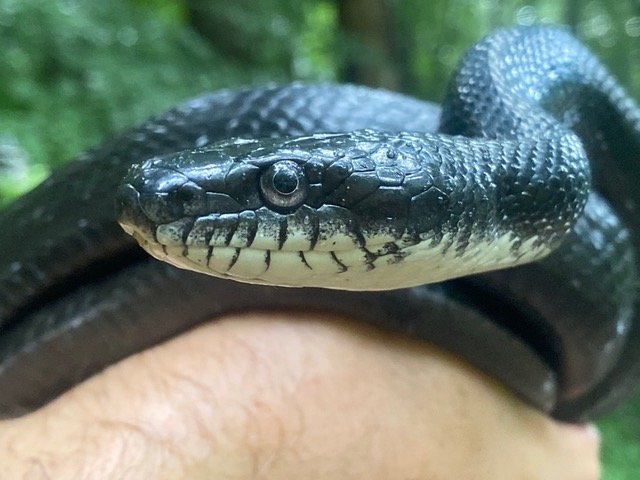
Snake Removal
See a snake? Just call!
We provide donation-based snake removal.
See a snake? Just call! us.
Here at Humane Homes we have a wonderful team of Snake-Loving Volunteers. We call them our Snake Relocation Team! Call our main number. Select the option for Snakes. Then text any snake pictures and your information to us (the number is provided when you call). We will review and respond and sent a dispatch request to our snake volunteers.
A simple snake capture and relocation is non-profit work here at Humane Homes. We accept donations in exchange for this service. Every month we make a donation to Triangle Land Conservancy (TLC) that meets or exceeds what we collect. TLC buys ecologically, culturally and historically significant lands around the area for long term conservation of native habitats and watershed protection.
One reason there are conflicts between humans and wildlife is due to habitat loss caused by human development. Supporting TLC is a way of giving back to the land and beings we co-exist with. This offsets habitat loss due to development. We feel we owe this to the snakes and all wildlife.
How do I keep copperheads off my property?
Clear cut your whole lot, pave it and paint it black. This way there is no natural habitat and if a snake does show up you will be able to see it. Totally joking. Seriously, we use this example to express a point - copperheads are common provided there is suitable habitat and food. Short of the above recommendation (and even if you did that) you will likely still see snakes around. And yes, the more natural or semi-landscaped the terrain, the more available habitat and food for snakes. Remember though: snakes, including copperheads, are free rodent control and serve a vital function in the eco-system. A single snake can eat 100-200 mice per year! They also eat lizards, frogs, other snakes, grubs, insects, rats, voles, moles, shrews, etc. If there are snakes around it is a good sign you have a healthy ecosystem on your property.
A more realistic question may be “How do I avoid getting bitten? -or- “How do I make sure my dog or kids don’t get bitten?” Basically, how can I live and move around my home and property without worry and anxiety about snakes?
Here are some facts to start. Copperheads are the only venomous snake found in the Triangle. Their bite is not inherently fatal.. Copperhead venom is a hematoxin which affects the blood and tissues. The bite is serious. Any person or pet that is bitten should get medical attention immediately.
Gracie my 20-pound Jack Russell survived two bites in one summer. The vet gave her fluids, antibiotics and pain medicine. And at $700 per visit and we got out of there cheap! If you have a fenced yard consider our Wildlife Barrier Fence to keep snakes and other wildlife out.
How to Avoid Encounters with Copperheads
Here are some tips that can reduce the chance of an unexpected encounter with a copperhead.
1. Look at a lot of copperhead pictures or videos (scroll down for a few). Train your mind- and your children’s- to quickly see a copperhead, to recognize it sooner than later. This is generally how our mind operates with any object in our surroundings. The brain is wired to learn and recognize patterns.
2. Wear closed-toe shoes or boots.
3.Carry a stick or small rake to survey your space and move the brush. Look for snakes. If you see one and can do so safely, take a picture and send it to us. We will be happy to confirm the identity. There are also several snake ID groups on Facebook.
4. Clear as much brush as possible. Remove rocks and debris, and anything under which a snake could hide. There are many things I see on people’s properties that are great places for snakes: branches, logs, tarps, sheets of wood or plastic, lumber, roof shingles, sheet metal, plastic swimming pools, etc. Focus on clearing the areas where you are the most; or focus on a 10-15 foot perimeter around the house.
5. Wear heavy gloves! Copperhead fangs are very small. Like an 1/8”. The heavier the hand coverings the less likely their fangs will reach your finger. Nearly every human copperhead bite I have heard of was on the toes, foot, ankle or fingers. And they are very painful!
6. Use a bright flash light, too, and look carefully before moving things. Even during the day before reaching into or under shaded areas. Copperheads do become predominately nocturnal when day time temperatures are in the 80’s and 90’s.
7. Before letting your kids or dogs outside, walk through the areas they frequent. Look closely following the tips mentioned above.
8. Keep your dog on a leash when outside and keep the dog close to you.
9. If you have fenced-in the yard consider installing a snake barrier. We can help with these.
10. Focus on reducing mice under or inside your home. This will minimize the chances of snakes ending up in there. This too we can help with!
11. Cicada blooms- Copperheads love to eat newly emerged cicadas! Around the base of oak trees is one common site for cicadas climbing out of the ground and latching onto trees.
12. If you see a snake on your property and want to encourage it to leave, give it a gentle spray from the hose. This works very well. And you may never see that snake again.
Copperhead Features
-Heavy-bodied
-2 to 3 feet average adult length
-Light brown/coppery or tan background color
-Strongly contrasting dark brown hourglass pattern, narrow in the center of the back, wide along the sides
-Triangular head, quite distinct from the neck, with a thin, dark line running from the eye to the rear of the jaw
-No pattern on head
-Vertical pupils (like a cat)
-Heat sensory pit on either side of head between eye and nostril
-Back scales are keeled (have a ridge running down the middle) and not shiny
-Babies have bright green tails





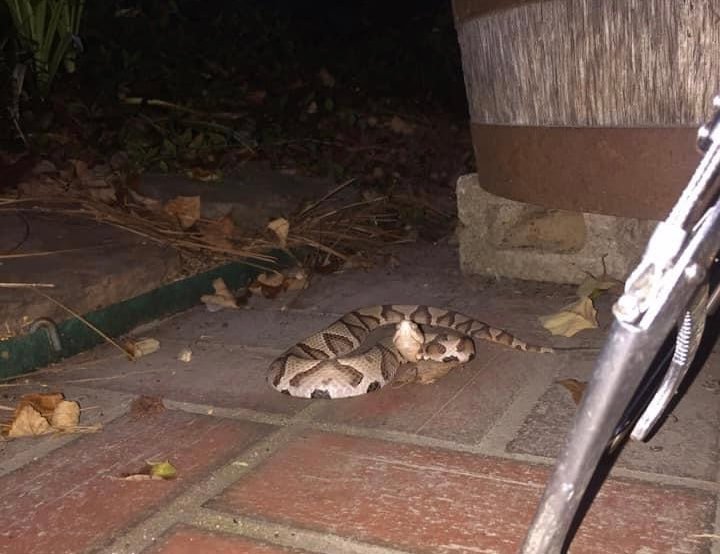
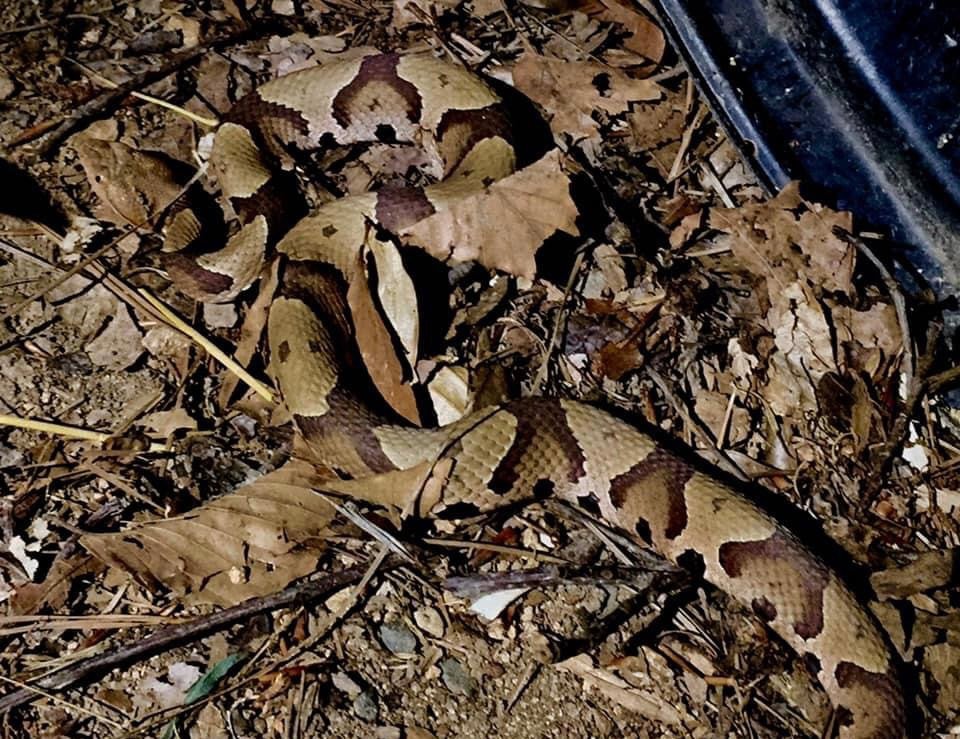
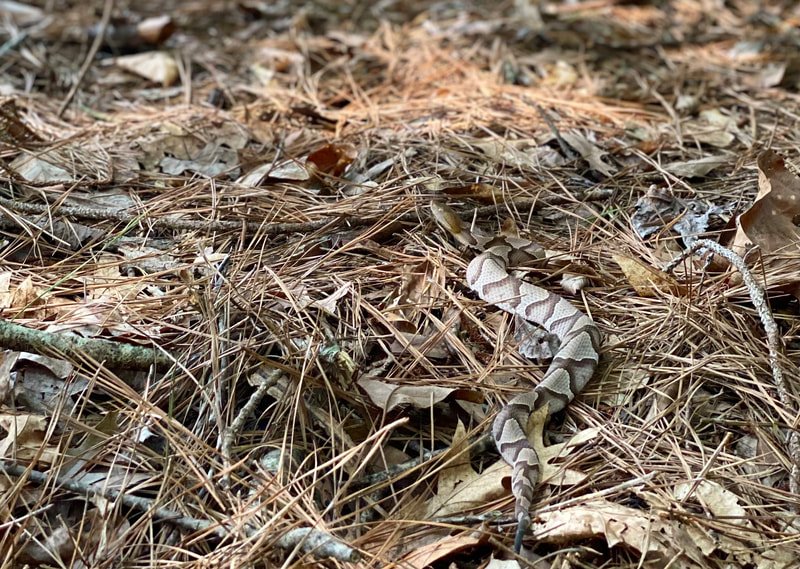
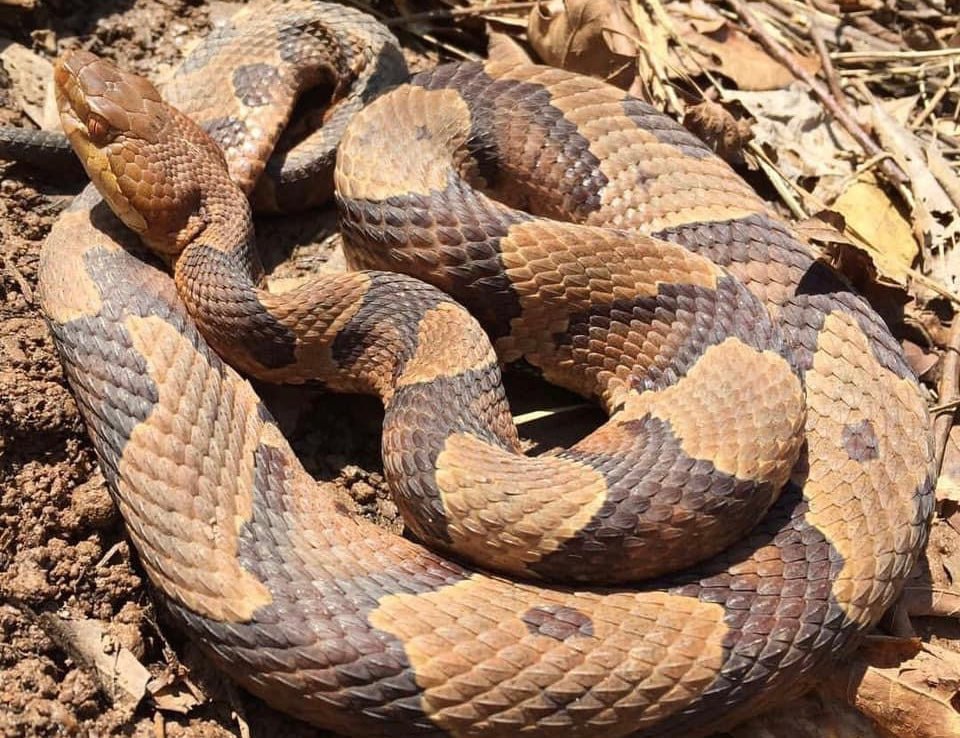

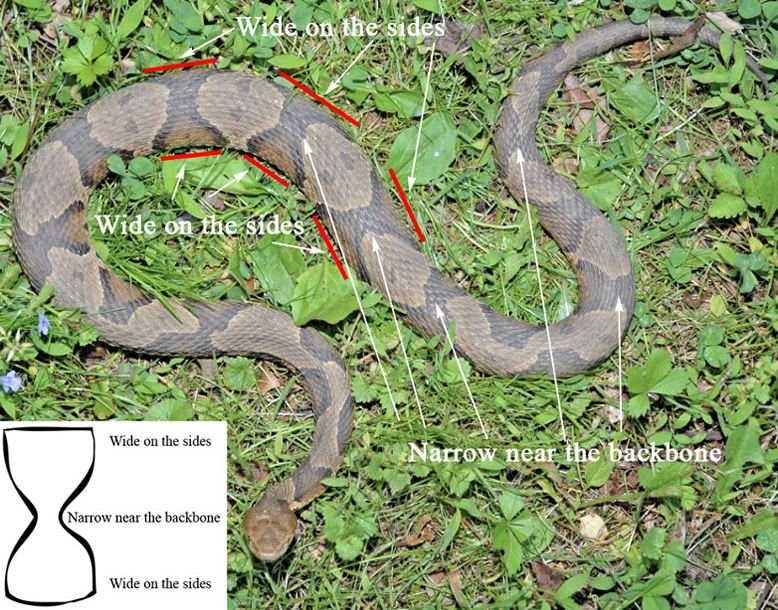



Above are a few copperheads. With babies/juveniles,
note the obvious lime green tail.


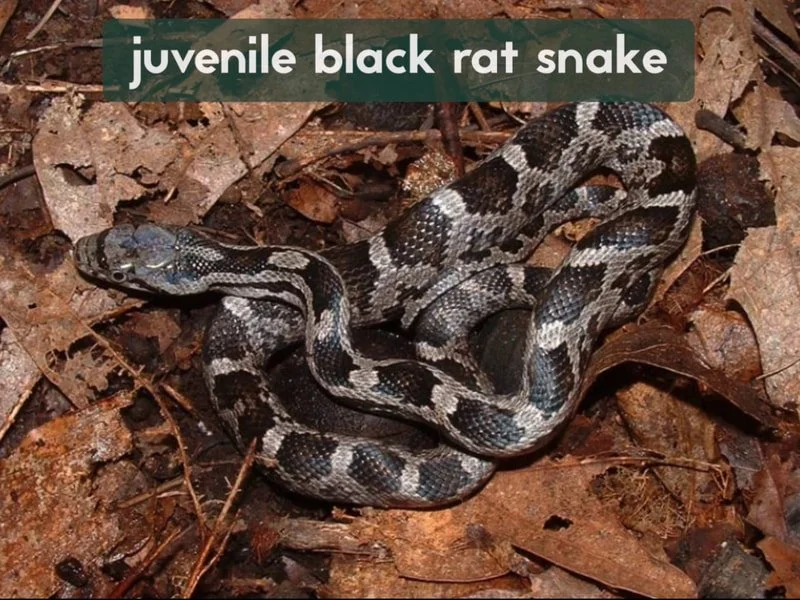




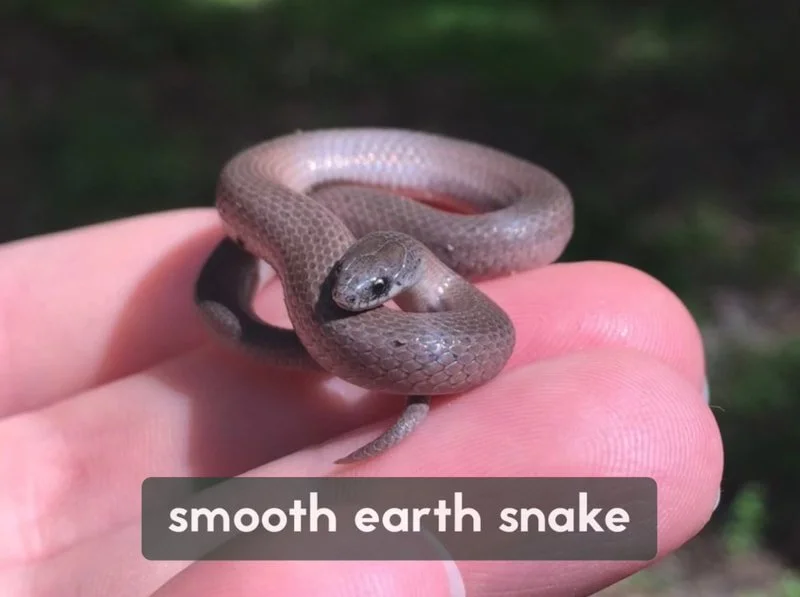
Above are a few examples of snakes local to the Triangle who are NOT copperheads.
For a wonderful resource on ALL NC snake species with pictures and key points,
visit the NC Wildlife Resources Commission.
Do other snakes keep copperheads away?
According to some, black rat snakes may occasionally eat copperheads but this is generally uncommon. The eastern king snake does eat other snakes, however their numbers in our area have diminished with habitat loss.
Black rat snakes (aka eastern black snakes) do eat mice and rats, as do copperheads. One theory is if one species of snake is prominent on your property you may see fewer of the other due to competitive pressures. So if you only see black rat snakes, there may be fewer copperheads, and visa-versa. Yet more than likely they are co-existing provided there is suitable habitat and food.
What about snake deterrent sprays and powders?
If you find one that is proven to work please let us know. Also, it needs to be non-toxic to the water, soil, wildlife and humans. Moth balls and snake-away powders do not work and are highly toxic. Google the active ingredient, “naphthalene.”
What about sticky traps?
Sticky traps are torture chambers. Snakes, mice, birds, lizards, birds and anything else can end up in there. They then struggle to the end of their life trying to get out. Many are seriously injured and can lose limbs or eyes trying to escape. We have found bats, bat wings, squirrel tails and mouse legs in sticky traps. There are no-harm methods to get wildlife out of your structure.
Do you do snake removal?
Yes, we can remove snakes from your property.
However, please consider what will happen when a snake is removed from your property (its native home turf). It will create a hole in the ecosystem. That one snake eats 100+ rats, mice, lizards, cicadas and or frogs per year. With the snake gone a couple things can happen. One, the number of mice and rats will increase around your home, which means there is a higher chance they will end up under or in your home. Two, another snake or two will move in when they find the available food. Will it be a copperhead or another species? I do not know. Relocation is not the best thing for the snake, as it increases their chances of mortality. Is it a death sentence? I don’t think so. But it can definitely be stressful.
As you can see, capturing and relocating is not so simple. It feels good and creates a sense of reassurance because you see the snake removed. We are willing and do often remove copperheads if that is what the client would like. Up front we want to make sure clients are aware of the possibilities and effects.
If you see a snake and need help, just call. We will do what we can, including capture and relocation. Ideally, we want to see humans and wildlife co-existing without harming each other. We do realize this is not always a viable option. If the choice is seeing it killed or relocating it, we are happy to relocate.
Interested in becoming a volunteer snake relocator? Contact us!
Effective Services Offered
Reducing food source, habitat, and installing physical barriers are the most effective and non-toxic methods we have found to reduce the chance of a copperhead on your property. We offer crawl space assessment, yard assessment, and barrier fencing. During crawl space assessment, we assess the foundation focusing on mouse activity (snake food), provide a detailed report of what we found, and estimate for removal, repair, remediation, and prevention. That's removal of animals, repair of damage or access points, clean up, and proactive reinforcement of areas highly susceptible once the primary access points are sealed.
During yard assessment, we can walk you through your property, pointing out habitats for snakes, why they're attractive, and what can be done about them. Any prevention services will also be detailed in an estimate.
Barrier fencing is a practical solution if you have an existing fence. Simple urgent care visits can easily reach many hundreds of dollars and much more. Barrier fencing can pay for itself if you prevent one copperhead bite. There's also greater peace of mind, which is priceless. Check out pictures and details of these services here.



